This Is What Happened To Data From Star Trek
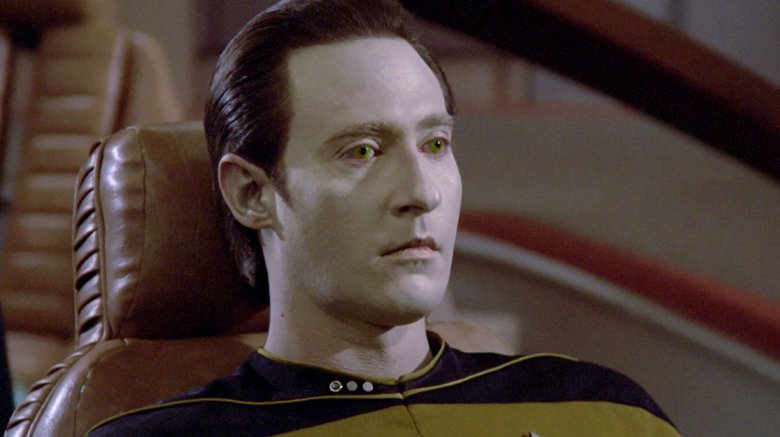
We may receive a commission on purchases made from links.
As Lt. Commander Data on Star Trek: The Next Generation , Brent Spiner saved the ship on more than one occasion, provided comic relief, and allowed the show to explore ethical questions of personhood, sentience, and even slavery through his android character's very existence. In addition to his role as Data, Spiner also portrayed other characters on the show, such as Data's "brother" Lore and his "father," Dr. Soong. But what happened to Data after the series was over—and what has actor Brent Spiner been up to since?

Independence Day
In 1996, Spiner made an appearance in Roland Emmerich's smash science fiction hit Independence Day —although many fans may not have recognized him, because his character was so drastically different from Data. You can spot Spiner in the part of Dr. Brackish Okun, the unkempt and enthusiastic director of Area 51 who joins a surgical team during an autopsy on one of the aliens. Although Okun appears to meet a messy end, it was revealed that he survived; Spiner returned to reprise his role as Okun in the 2016 sequel, Independence Day: Resurgence .
Data after TNG
Although The Next Generation ended its television run in 1994, that wasn't the end of Data's story. Spiner returned to the role in four Star Trek movies featuring the TNG cast, starting with Star Trek Generations (1994) and followed by Star Trek: First Contact (1996), Star Trek: Insurrection (1998), and Star Trek: Nemesis (2002).
Throughout the big-screen Trek franchise's TNG era, Spiner had a variety of opportunities to explore his character's arc further. In Generations , Data finally decides to install the emotion chip Dr. Soong created for him, with mixed results. In First Contact , he plays an integral role when he's captured by the queen of the Borg Collective, who attempts to turn him against the Federation. During Insurrection, Data becomes a central part of the plot when he "malfunctions" during an away mission—which leads Picard and the crew of the Enterprise to discover a shadowy plot.
In Nemesis , Spiner played dual roles, appearing as B-4, an earlier Soong-type android, as well as Data, who works with the rest of the crew to stop a Reman leader determined to destroy the Romulan Empire and wipe out all life on Earth.
Return to Star Trek
Even though Data's storyline was wrapped up during the course of 2002's Star Trek: Nemesis , the franchise wasn't completely done with Spiner. While the door was left open for the character of Data to potentially return, Spiner felt he'd gotten too old to play the ageless android—but in 2004, he appeared on the prequel television series Star Trek: Enterprise in a three-episode arc as Arik Soong, a geneticist and ancestor of Data's creator, Dr. Noonien Soong.
In the episodes, Soong—a doctor of genetics with questionable ethics—steals and alters some genetically engineered embryos. In doing so, he creates the "Augments," who he regards as his children. Although he's imprisoned for his actions, Soong is later recruited by the Federation to help track down and stop his "children," who are running violently amok in the galaxy and attempting to start a human-Klingon war.
In 2011, Spiner co-created and starred in his own web series, Fresh Hell . The show, available on YouTube, depicts a fictionalized version of Spiner, who's trying to rebuild his career after an unspecified high-profile "incident" causes him to lose everything. The comedic take on Spiner's career shines in the writing, such as when a talk show host tells a guest, "We had a guest on yesterday whose face was literally ripped off by a pit bull. You know what she said to me? 'At least I'm not Brent Spiner.'" Spiner takes a neighbor under his wing, an erstwhile porn star who wants to become a real actress, and the two attempt to break back into Hollywood together. The episodes are short and funny, and fans who haven't seen it yet should definitely give Fresh Hell a watch.
The Master of Disguise
In 2002, Spiner appeared as bad guy Devlin Bowman in the Dana Carvey comedy The Master of Disguise . Bowman has just finished serving a two decade prison sentence, and he's determined to get his revenge on the man who put him in prison—who just happens to be the father of Carvey's character, Pistachio Disguisey. After Bowman kidnaps the elder Disguisey, it's up to Pistachio to follow in his father's footsteps and learn to be a "master of disguise" in order to save him.
Basically, the entire movie was a vehicle to showcase Dana Carvey's impressive mimicry skills, and it didn't work: The Master of Disguise was a critical flop that, according to the BBC 's film critic, made other juvenile humor films like Deuce Bigalow: Male Gigolo "look like the comic equivalents of Citizen Kane ."
In 2005, Spiner starred along with Peter Dinklage and Carla Gugino in the CBS sci-fi series Threshold . The trio formed the core of a secret U.S. governmental think tank tasked with humanity's first extraterrestrial contact, with Spiner playing Dr. Nigel Fenway, a NASA microbiologist brought onto the top-secret "Red Team" in charge of researching and containing an incident on an American naval vessel where several crew members died horribly after encountering an unidentified flying object. What Fenway and the rest of the team discover about the aliens and their ability to manipulate DNA could possibly put the entire world at risk. Although it was canceled after only one season, Threshold is a must-watch for Brent Spiner fans.
Voice acting
Because Spiner has such a rich theater background, it probably shouldn't be surprising that he's done plenty of voiceover work over the years. He's skilled at doing impressions of other actors, and has been known to spoof his TNG co-star Patrick Stewart at sci-fi conventions. In the 1999 movie South Park: Bigger, Longer & Uncut , he provided the voice of talk-show host Conan O'Brien, and he's also taken voice roles on several TV shows, including Generator Rex , Young Justice , The Avengers: Earth's Mightiest Heroes , The Simpsons , Star Wars Rebels , Hulk and the Agents of S.M.A.S.H. , and Justice League Action . If you're a fan of the video game Elite Dangerous , now you can get Spiner's voice in your spaceship; he provided a voice pack for Vega in 2016.
Since 2016, Spiner's biggest project has been the Cinemax horror series Outcast , in which he plays Sidney, a mysterious preacher involved in a tale of demonic possession and other supernatural happenings in a small West Virginia town. In an interview with the A.V. Club , Spiner compared Sidney to Data. "[Sidney] is the most difficult character to describe on the show," he argued. "But kind of like Data on Star Trek , I'm finding this character similar in the sense that we're sort of discovering him and building him as we go along. It's kind of like I'm figuring out the character at the same time the audience is."
For fans who loved Spiner's work as Data, seeing him in such a dark role might be disturbing at first, but it showcases a menacing side of his acting—one we haven't really seen since Data's brother Lore was deactivated for good.
Brent Spiner Wants A Star Trek Spin-Off Series About Data's Creator Noonian Soong
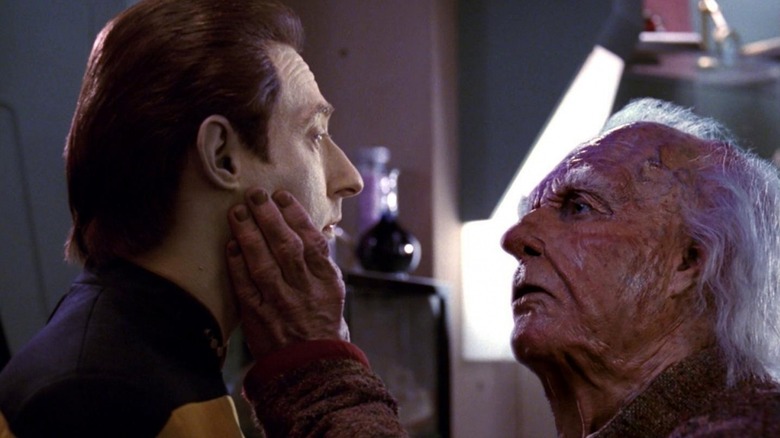
As of this writing, actor Vaughn Armstrong still holds the record for the most number of characters throughout "Star Trek." Jeffrey Combs technically might have Armstrong beat, but that's only if you count multiple identical clones as separate roles.
Of the main cast, however, Brent Spiner currently holds the record for playing the greatest number of characters. Apart from his central role as the android Data on "Star Trek: The Next Generation," Spiner also played his own evil twin brother, Lore, a Data prototype named B-4 (in "Star Trek: Nemesis"), and the androids' creator Dr. Noonien Soong. On "Star Trek: Enterprise," he played Dr. Arik Soong, an ancestor of Noonien, who was a villain keen on eugenics. In "Star Trek: Picard," he played an even more distant ancestor Dr. Adam Soong, who lived in the year 2024. In both the first and third seasons of "Picard," he also played Dr. Altan Soong, Noonien's biological son. That's seven roles in all.
This number doesn't count the "Next Generation" episode "A Fistful of Datas" wherein a holodeck malfunction transformed the population of an entire artificially created Old West town into Data. In that episode, Spiner played at least four additional characters.
Spiner recently returned to "Picard" to play an amalgam character . It turns out that Altan created an android that contains the brain of Data, Lore, Dr. Soong, B-4, and even Data's daughter Lal. Spiner, who has been ambivalent about playing Data in the past , clearly welcomed the acting challenge of playing so many characters at once.
In a recent interview with Comics Beat , Spiner, now 74, floated the idea of playing Noonien again. His ideas are tantalizing.
Often Wrong Soong
At the start of "Star Trek: The Next Generation," Data had no memories of his earliest days alive; he was discovered abandoned in pieces on a remote Federation outpost and reassembled by Federation scientists. His creator, Dr. Soong, was presumed dead, a fact confirmed by his brother Lore. By the show's fourth season, Data and Lore would be remotely summoned by Dr. Soong, now incredibly old and eager to give Data an emotions chip; Data was incapable of feeling because of the missing chip. Data, rather logically, asks Dr. Soong why he was created. They have a brief exchange about how humans are fascinated by the past and are eager to perpetuate into the future. Having children, Soong argues, is a way of assuring immortality.
But little was revealed about Soong's life and philosophy at large, though it was implied that he inherited his interest in androids from several previous generations. The details of Noonien himself, however, have yet to be explored. Brent Spiner suggested finally covering Soong's life in a standalone "Star Trek" series. When asked if he'd even play all seven of his characters at once, Spiner quipped:
"One can only hope! It's high time, don't you think? I don't think that's ever going to happen. I think this one's as close as you're going to get. You know, I think I'm too old — but I would like to see the ultimate Soong episode, or series or miniseries. Just finding out who this family is. Where they came from, really. Because you always have to ask yourself: "How did this guy get a Chinese last name? Who was he, really? Why are all iterations of him so into eugenics and creating perfect species?"
As was iterated in "Picard" and "Enterprise," the Soong family was weirdly fixated on "the perfect being," and both Adam and Arik were eager to manipulate genetics to that end. Indeed, it was Arik's genetic tinkering with Klingon DNA that caused them to more closely resemble humans for a few generations. That was the in-canon excuse as to why Klingons looked human in the original "Star Trek" series, but why they had pronounced alien foreheads in "Next Generation." Arik, when apprehended for his genetic crimes, announced that a positronic being might be the way to go, and that it would only take a few generations to make an android. The genetic manipulation would also explain why multiple generations across the centuries all happen to look exactly like Brent Spiner.
It was never explained, however, why the Soongs started on that path the begin with. Spiner wanted to look at that more closely.
While Spiner clearly has a knack for playing multiple characters in a scene — or perhaps the scripts he was handed allowed him that opportunity — he did say that he wouldn't necessarily want to play Dr. Soong in a spinoff series. "It's a really intriguing story of a family," he said. "It could even be told without me. There could be other actors who do it."
Not only would this allow Spiner's acting legacy to continue in "Star Trek" for perpetuity, but it would allow other, newer performers to step in. Also, seeing as how the androids are essentially immortal, but human actors are not, shunting Data's brain into new bodies would make sense in canon.
Just about anything can be explored in "Trek" right now — there are six shows at once! — so why not a Soong miniseries?

Enterprise Lab Group
Boldly going where no one has gone before.
Phone: 480-444-5555
Fax: NCC-1701D
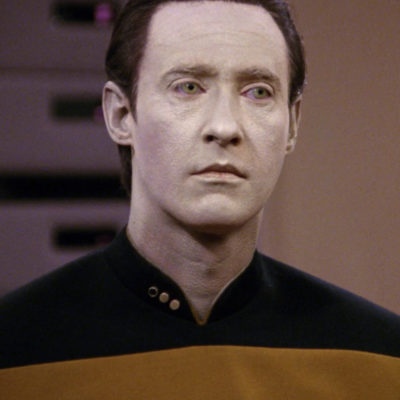
Second Officer
- [email protected]
- 4592-34-54233-52345
- Deck 34, Room 55
Data ( /ˈdeɪtə/ DAY-tə ) is a character in the fictional Star Trek franchise. He appears in the television series Star Trek: The Next Generation ( TNG ) and the feature films Star Trek Generations (1994), Star Trek: First Contact (1996), Star Trek: Insurrection (1998), and Star Trek: Nemesis (2002). [1] Data is portrayed by actor Brent Spiner .
Data was found by Starfleet in 2338 as the sole survivor on Omicron Theta in the rubble of a colony left after an attack from the Crystalline Entity . He was a synthetic life form with artificial intelligence and designed and built by Doctor Noonien Soong in his own likeness (likewise portrayed by Spiner). Data is a self-aware , sapient , sentient and anatomically fully functional android who serves as the second officer and chief operations officer aboard the Federation starship USS Enterprise -D and later the USS Enterprise -E .
His positronic brain allows him impressive computational capabilities. He experienced ongoing difficulties during the early years of his life with understanding various aspects of human behavior [2] and was unable to feel emotion or understand certain human idiosyncrasies , inspiring him to strive for his own humanity. This goal eventually led to the addition of an “emotion chip” created by Soong, to Data’s positronic net. [3] Although Data’s endeavor to increase his humanity and desire for human emotional experience is a significant plot point (and source of humor) throughout the series, he consistently shows a nuanced sense of wisdom, sensitivity, and curiosity, garnering respect from his peers and colleagues.
Does Star Trek's Data Come from a Family of Monsters?

Your changes have been saved
Email Is sent
Please verify your email address.
You’ve reached your account maximum for followed topics.
- The Soong family has long been established as Star Trek's go-to mad scientists who are responsible for Khan and Lore, among other atrocities.
- Data is the exception to that rule as a genuine force for good in the galaxy and perhaps the only non-selfish thing his family ever produced.
- This major differnce is a big part of what makes Data such a singular and compelling character in the franchise.
Lieutenant Commander Data regularly tops any list of the most beloved Star Trek characters of all time. Originally intended as the "not-Spock" for Star Trek: The Next Generation , he quickly stepped out of his predecessor's very long shadow thanks to a compassionate performance from Brent Spiner. He may be Star Trek's most ethically upstanding character, ironically due in part to his inability to feel emotions for most of his existence. While Spiner never played Data outside the context of The Next Generation until the big reunion in Season 3 of Star Trek: Picard , he eagerly returned to the franchise multiple times to portray various members of the Soongs, the family that created him.
The move worked out well, allowing Spiner to stretch his wings as an actor while keeping his hand in the saga even after Data was gone. It also gave Star Trek a perennial family of ne'er-do-wells, turning the Soong family into the franchise's go-to mad scientists. Some of the galaxy's most dire threats -- including Khan Noonien-Singh and Data's homicidal brother Lore -- sprung directly from their schemes, and Spiner's range allowed him to play their sinister qualities to perfection. That leaves Data a viable anomaly within their ranks, akin to the son of a Mafia don who becomes a priest rather than getting involved in the family business. In the process, he gives the Soongs a single brilliant success story -- the creation of a new life form -- that brings considerable nuance to their centuries of dark deeds.
The Soongs Are Star Trek's Mad Scientists
The star wars franchise is in its 'star trek: the next generation' era.
People inevitably compare Star Wars and Star Trek, and the former's evolution as a franchise is akin to The Next Generation era of its development.
Ironically, the Soong line begins in the canon timeline with Picard Season 2, and the 21st century's Adam Soong, a doctor of genetics devoted to creating artificial life. He almost succeeds with his "daughter" Kore, but she retains genetic defects that force her to live in a highly controlled environment. He makes a deal with Q to alter human history for the worse in order to save her, but Kore learns her true nature and deletes his database in retaliation. He's last seen in Picard Season 2, Episode 10, "Farewell," opening a file labeled "Project Khan." It implies that Khan -- and the Eugenics Wars -- are a result of his efforts, an assumption which is borne out in Star Trek: Strange New Worlds Season 2, Episode 3, "Tomorrow and Tomorrow and Tomorrow" when La'an Noonien-Singh discovers the results of the project.
That's borne out by his descendent Arik Soong, who lives over a century later in the era covered by Star Trek: Enterprise . He appears in a three-episode arc, starting with Season 4, Episode 4, "Borderland" and ending with Season 4, Episode 6, "The Augments." In the wake of the Eugenics Wars, humanity abandons genetic manipulation, something Arik feels is a big mistake. He steals augmented genetic embryos from the research facility where he works and brings them to term, then raises them as his "children." They grow up as dangerous as Khan, and threaten to start a war with the Klingons before Captain Archer and the Enterprise bring them to heel. The Klingons feel the sting of Soong's work as well, as their attempts to duplicate his genetic manipulation threaten to destroy their species in Season 4, Episode 15, "Affliction."
Data Is the Only 'Good Soong' in Star Trek
Picard's brent spiner explains why data didn't really die in star trek: nemesis.
Star Trek: Picard star Brent Spiner explains why Data didn't really "die" in the 2002 feature film Star Trek: Nemesis.
Regardless, Noonian's work only furthers the disastrous record of his ancestors, all of whom hoped to "perfect" human life only to unleash monsters upon the world. It's made them some of the franchise's go-to mad scientists, helping to further Star Trek's periodic retakes on the Frankenstein story . Data is the big exception to that as an artificial creation imbued with a genuine moral compass who becomes a great force for good in the galaxy. His lack of emotions ironically makes him humble and unassuming despite his brilliance. It also gives him the ability to understand and appreciate ethical issues without personal bias, while defending his convictions without flagging. He's even a scientist like the other Soongs, though his experiments are invariably ethical and above the board.
A strong early example arrives in The Next Generation Season 2, Episode 9, "The Measure of a Man." Riker is forced to argue convincingly for Data's dismantling, lest the judge summarily rule against Data's status as a person. As Riker berates himself afterwards, Data arrives to thank him, pointing out that Riker did what was necessary to help him win the case. Similarly, in Season 6, Episode 9, "The Quality of Life," when Data realizes that the mechanical "exocomps" he's working with have attained sentience, he's willing to risk Geordi and Jean-Luc's safety in order to preserve their autonomy. He never wavers in his conviction despite enormous pressure from those around him, and allows the exocomps to be accepted as sentient beings as a result.
Data eventually gains emotions with the help of a chip his father made for him. But he doesn't activate it until the events of Star Trek: Generations , by which time his identity and moral principles are well-established. That continues into his resurrection in Picard Season 3, Episode 8, "Surrender" in which he integrates Lore and some of Soong's other android creations into his reborn personality. But for the entirety of The Next Generation's runtime, he's utterly incapable of feeling anything, including the pride, ego and vanity that drove the other Soongs to commit their dark deeds. It suggests that Data's signature emotional detachment is at least partially responsible for his development of healthy ethics.
Data's Decency Adds to Star Trek's Ongoing Moral Debate
Star trek: picard season 3 honors every version of data.
Data is back on Star Trek: Picard once again, but like the rest of Season 3 his appearance honors every version of the character, good and evil alike.
Data's design also puts the Soongs' previous work in an interesting context. As the culmination of their largely catastrophic efforts to artificially create life, he becomes everything they might have hoped for. While that doesn't validate their various crimes, it suggests that -- without their efforts -- the galaxy might have been deprived of a figure that literally saved it more than once. If a "good" creation like Data can emerge from "evil" scientists like the Soongs, does it discount their previous deeds? Star Trek doesn't answer the question, but it often debates it while exploring the Soongs' plans.
Arik and Adam arrived on the series well after Data had become a beloved icon, and shades of Noonian's success with Data can be seen in their own failed efforts. They too have "children" whom they profess to love and they too believe that what they're doing will ultimately benefit the entire galaxy. The fact that Noonian finally got it right speaks to the necessary trial-and-error of scientific advancement, letting the franchise debate the age-old moral question of whether the ends justify the means. Ultimately, it helps make Data a more interesting character. The Next Generation premiered with his origins a mystery, and only began shedding light on it starting in Season 1, Episode 13, "Datalore."
The more Star Trek revealed, the worse the Soongs became, leaving his gentle and compassionate nature a true miracle. But it also delivers another level of ethical discussion, giving his creation a dark side and exploring questions of the greater good. It helps temper Data without reducing his innate decency. Spiner's subsequent appearances have all informed his first in some way or another, and while their various efforts make a terrific topic of ongoing discussion among fans, they also facilitate some much-needed complexity in their prodigal son. Star Trek celebrates optimism and the better angels of human nature. With the Soongs, the franchise leans hard in the opposite direction, and produces a far more interesting Lieutenant Commander Data in the process.
Star Trek: The Next Generation
Set almost 100 years after Captain Kirk's 5-year mission, a new generation of Starfleet officers sets off in the U.S.S. Enterprise-D on its own mission to go where no one has gone before.

Lal was a Soong-type android constructed by Data in 2366 on the USS Enterprise -D . She exceeded Data's capabilities in several ways, notably by being able to complete more than sixty trillion calculations per second , using verbal contractions , and feeling emotions such as fear and love .
- 1.1 Conception and creation
- 1.2 Becoming Human
- 1.3 A proposed separation
- 2 Potential appearances
- 3 Memorable quotes
- 4.1 Appearances
- 4.2 Background information
- 4.3 Apocrypha
- 4.4 External links
History [ ]
Conception and creation [ ].
Technology in the 2360s prohibited the successful creation of a stable positronic brain , with Data being the one exception. ( TNG : " The Measure Of A Man ") When he learned of a newly-developed submicron matrix transfer technology at a cybernetics conference he had attended in 2366, he decided to proceed with the creation of one like himself. Using his own positronic brain as a template, Data programmed the brain of the android that was ultimately known as "Lal". His initial tests proved successful, so he returned from the conference with the new brain.
Lal's creation allowed Data to accomplish two things – to re-create the work of his " father ", Noonien Soong , and to experience the act of procreation , having a family, and leaving behind a legacy should he perish. Data chose the name for his offspring from a Hindi word meaning "beloved".
Data's eventual hope was that someday his daughter would enter Starfleet Academy and serve in Starfleet , as he had. He wished to give back to the organization that had given him so many opportunities. Regardless, he felt that ultimately, it was his role to parent her, not Starfleet's. To this end, he consulted all the available literature on parenting aboard the Enterprise -D.
Originally genderless and possessing a very basic humanoid appearance, Lal was allowed to choose a gender and a personal appearance. Deanna Troi reminded Lal that Lal's choice would affect how people interacted with the android. Lal originally wished to share gender and features with Troi, but Data discouraged the move, saying it would be confusing.
After narrowing the choices from several thousand composites Data had programmed to four finalists – an Andorian female , a Human male and female, and a Klingon male – Lal chose the Human female form. Additionally, she was given a skin pigmentation and eye type consistent with Human females, as opposed to Data's less Human features.
Becoming Human [ ]
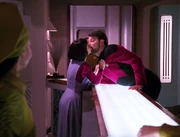
Lal introduces herself to Riker
Data wished for Lal to learn about "being Human", and per Wesley Crusher 's suggestion, enrolled her in the ship's school . Unfortunately, she was not able to socially interact with the older children, who were closer to her level of intelligence, and the younger children were afraid of her. When discussing her interactions with the children, Lal believed she had unintentionally made jokes , saying they had laughed at her remarks. Data explained that they were laughing at her, not with her, mainly because she was different from them.
Data then sought parental advice from Beverly Crusher , explaining he did not know how to help Lal with her realization that she was different from other people. Crusher suggested that he share his own experiences to encourage her, something he had not done, believing that it would only discourage her instead.
Data then decided that allowing Lal to work in Ten Forward would give her more valuable insight into Human social interaction. She was mentored by Guinan , who tried to answer all of her questions, but left matters of sex for Data to answer. While working in the bar – as she was conveniently programmed with a listing of 1,412 known beverages – Lal began to improve on her father's original specifications, becoming able to use verbal contractions and even, eventually, to feel emotions . Her knowledge of proper behavior and timing was still lacking, however; after observing a couple's romantic interactions, she hauled an unsuspecting William T. Riker up off the ground and kissed him, despite the two having only just met each other.
A proposed separation [ ]
When Starfleet Research learned of Lal's existence, Vice Admiral Haftel , a cyberneticist himself, attempted to separate Lal from Data in order to study her closely. Aghast at the idea of her working in Ten Forward, he believed the Daystrom Institute annex on Galor IV would be a better environment for her. Lal was then interviewed by Haftel, and agreed that his facilities would be beneficial to learn, but only after having completed her learning aboard the Enterprise with her father. At one point the admiral stated how much respect he had for Data, but Lal pointed out that he in fact was not speaking with respect.
The situation caused Lal distress, and while speaking with Deanna Troi, she began to feel fear over her impending separation from her father. Her programming perceived a malfunction, causing her to return to the Enterprise lab, as she had been programmed to do in the event of a problem.
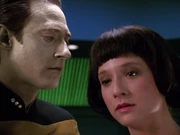
" Thank you for my life. "
Upon running diagnostics, Data identified the problem as a symptom of a cascade failure in her neural net . With the assistance of Admiral Haftel, he attempted to repair the damage. However, despite their best efforts, the effect was irreparable, and Lal's neural net failed.
Haftel described the experience to a waiting La Forge , Troi, and Wesley Crusher: " There was nothing anyone could have done. We'd repolarize one pathway and another would collapse. And then another. His hands were moving faster than I could see, trying to stay ahead of each breakdown. He refused to give up. He was remarkable. It just wasn't meant to be. "
As Lal was dying, she expressed her love for her father and thanked him for creating her, before summing up her brief life in a few short words. She succumbed to complete neural system failure at 1300 hours , after which Data deactivated her.
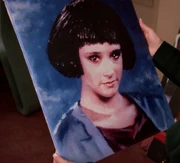
Data's painting of Lal
As a final act following her death, Data transferred Lal's memories and experiences into his own brain, ensuring a part of her would live on. ( TNG : " The Offspring ")
By 2368 , Starfleet had come to recognize that Lal was Data's offspring, and this was reflected in the crew manifest database file for Data. ( TNG : " The Offspring "; TNG-R : " Conundrum ")
Interestingly, the symptoms of Lal's shutdown achieved something Data had been trying to achieve for many years : basic Human emotions. It took five more years before Data achieved the same results in himself, and this only after implanting a new chip created by his "father". Though also suffering a neural net failure as a result, Data recovered and was able to function normally afterwards, even able to toggle the ability to feel emotion on and off at will. ( TNG : " Brothers "; Star Trek Generations ; Star Trek: First Contact )
Understandably, Lal remained in Data's thoughts for many years after. During his experimentation with painting , Data painted a portrait of Lal, which he later showed to Juliana Tainer – essentially, Lal's " grandmother " – when she visited the USS Enterprise -D in 2370 . Despite her unfortunate death, he still wished to procreate again some time in the future. ( TNG : " Inheritance ") He also painted Daughter , one of a pair of oil paintings and gifted both to Captain Picard in 2369 . ( PIC : " Remembrance ")
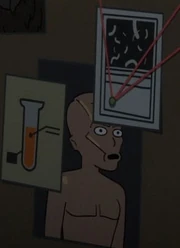
Photograph of Lal
A photograph of Lal in her incomplete form appeared on Beckett Mariner 's conspiracy board in 2380 . ( LD : " Cupid's Errant Arrow ")
While musing in 2399 on the creation of Dahj Asha through fractal neuronic cloning from one of Data's positronic neurons , Jean-Luc Picard remarked that Data had " always wanted a daughter ", a possible reference to Lal. ( PIC : " Remembrance ")
Altan Inigo Soong began working on an android that combined Lore, B4, the remaining remnants of Data, as well as Lal. Soong died in 2401 before he could complete his work, but the android was taken by Starfleet to the Daystrom Station where it was set up as a security system for the facility. ( PIC : " The Bounty ") After Data gained full control over the android, he stated that he was now not only Data, but Lore, B-4 and Lal as well. ( PIC : " Surrender ")

Potential appearances [ ]

Memorable quotes [ ]
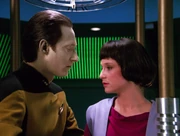
" I love you, Father "
" How do you do, Lal? " " I am functioning within normal parameters. "
" Why would they wish to be unkind? " " Because you are different. Differences sometimes scare people. I have learned that some of them use humor to hide their fear. " " I do not want to be different. "
" I watch them and I can do the things they do but I will never feel the emotions. I'll never know love. " " It is a limitation we must learn to accept, Lal. "
" Troi. Admiral. Admiral. An admiral from Starfleet has come to take me away, Troi. I am scared. "
" In all these discussions, no one has ever mentioned her wishes. She's a free, sentient being. What are your wishes, Lal? " " I wish to remain here, Captain Picard. "
" I feel " " What do you feel, Lal? " " I love you, Father. " " I wish I could feel it with you. " " I will feel it for both of us. Thank you for my life. Flirting. Laughter. Painting. Family. Female. Human. "
Appendices [ ]
Appearances [ ].
- " The Offspring "
- " Inheritance " ( painting )
- LD : " Cupid's Errant Arrow " ( photograph )
Background information [ ]
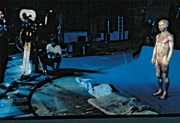
Leonard Crofoot filming the holodeck scene
Lal was played by Leonard Crofoot in the incomplete form and Hallie Todd in her feminine form. Kristina Kochoff played the holographic Andorian representation of Lal.
The name "Lal" is Hindi for "beloved". ( Star Trek Encyclopedia , 3rd ed., p. 258)
The Next Generation writing staff considered bringing Lal back in an unproduced fifth season episode, wherein Lore would return, steal Lal's remains and try to revive her with Dr. Soong's emotion chip, but it was rejected for unknown reasons. [2]
Leonard Crofoot was personally requested by Jonathan Frakes to play the role of Lal's unfinished form, which was created by Makup Designer Michael Westmore. In a 2015 interview with StarTrek.com , Crofoot recalled, " Michael Westmore did a plaster cast of my entire body, done in sections. The body of the costume consisted only of latex buns and an angular bra that was glued on, plus metallic contact lenses. The rest was naked me sprayed with metallic gold paint. Then Michael did his wonderfully creative sculpturing of the face in latex. I was very honored to read that Michael Westmore considered it one of his best efforts." Crofoot compared Lal to that of a child. "Lal was a fantastic part because I got to play an entity that wasn't fully formed. " he said. " I was the child of Data, so I needed to be a bit like him in my movement and yet also a child that is a separate being with its own life. And I had to do this mostly without dialogue. The story is profoundly tragic; the loss of a child is the worst loss. I have received wonderful mail from Next Generation enthusiasts and it tells me that the story is universal. I'm proud to be a part of it all." [3] [4]
Crofoot once spent a full fourteen hours inside the Lal prototype suit without eating or drinking in order to avoid having to use the bathroom while wearing his costume. ( Makeup Man: From Rocky to Star Trek ; [5] )

Jonathan Frakes directs Hallie Todd on set
Michael Westmore considers Lal to be his, " all-time favorite of every show. I thought it was wonderful. " [6]
The script for " The Offspring " describes Lal's initial appearance as, " an android, but it has no face, metallic eyes, and no hair. It is a primitive mannequin. When it speaks, its voice is computer-like, neither male nor female. […] The android shows nothing. It stands ramrod straight and perfectly still, and it displays no curiosity about the Human which is inspecting it. " It goes on to describe Lal's Human reveal as, " …she's the Human female, dressed in a flattering outfit […] She moves cautiously around the room… examining…as she looks at things for the first time… […] A short attention span… she is already moving onto something else… she runs her fingers across it… " Of her malfunction, the script says, " Starting on Lal's face who has regressed dramatically… she is more like the first mannequin we saw… slow, measured movements, loss of comprehension… […] Data looks at Lal with an impassive face… and yet we must sense the extraordinary weight of his failure on his shoulders… she looks as beautiful as ever, standing here before him. And yet she barely can move or talk. There is very little left of her. " [7]
In his review of "The Offspring", Star Trek author Keith R.A. DeCandido enjoyed Todd's performance as Lal, writing, " …the episode is made by Hallie Todd, who is simply fantastic as Lal. She modulates impressively from awkward to capable. Given less than 40 minutes to show Lal’s evolution and emotional collapse, she accomplishes it magnificently, being utterly convincing at every stage from the difficult beginning to the accomplished middle to the tragic end. " [8]
Apocrypha [ ]
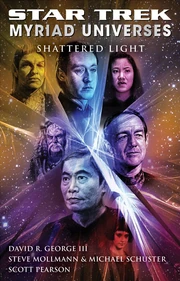
Lal on the cover of the Shattered Light anthology
Prior to Star Trek: Picard taking a new direction for canon, several novels from Pocket Books explored a different path for Data and Lal. In the Slings and Arrows eBook The Insolence of Office , set in 2373 , Data installs his emotion chip and begins to mourn Lal's death, an experience which causes him some distress. In Avatar , Book One , Data recalls Lal and the events of "The Offspring" during a flashback experience caused by his exposure to the Bajoran Orb of Memory , in 2376 .
The Cold Equations novel The Persistence of Memory reveals that, in 2384 , Lal's remains are kept at the Daystrom Institute, along with those of Soong's three original prototypes, B-4 , and Lore . She is briefly stolen by the Breen , but is recovered thanks to the crew of the USS Enterprise -E and Doctor Soong, who is still alive after transferring his mind into an android body. Soong is able to restore Data who then resolves to find the mysterious immortal known as Flint after hearing reports that Flint was responsible for reactivating Juliana Tainer after her positronic net shut down. Data succeeds in his mission in the follow-up novel The Body Electric when he is able to restore Lal's consciousness.
The Star Trek: Myriad Universes - Shattered Light short story " The Embrace of Cold Architects " is set in an alternate reality, wherein Data's creation of Lal in 2366 is delayed by several months due to the postponement of a cybernetics conference on Galtinor Prime. In this timeline, Jean-Luc Picard is able to focus on Lal's then-current presence on the Enterprise while held captive by the Borg, thus allowing their destruction (and Picard's death) at the hands of William Riker, who subsequently becomes captain of the Enterprise . Lal later survives her near-fatal cascade failure with the assistance of Doctor Noonien Soong and is taken by Admiral Anthony Haftel to the Daystrom Institute Annex on Galor IV . There, she becomes the template for the mass-production of androids intended to battle the Borg.
Lal also appears in the mobile multiplayer strategy role-playing game Star Trek Timelines , in which she is a "4-star" character with skills in diplomacy and engineering. She has the highest engineering rating of any of the 4-star characters in the game.
Lal also has a card in the Q Continuum set of the Star Trek Customizable Card Game .
External links [ ]
- Lal at Memory Beta , the wiki for licensed Star Trek works
- 1 Daniels (Crewman)
Screen Rant
Every soong character brent spiner plays in star trek.

Your changes have been saved
Email Is sent
Please verify your email address.
You’ve reached your account maximum for followed topics.
How To Watch All Star Trek TV Shows In Timeline Order
Data’s evil relatives: every soong’s biggest crimes in star trek, every star trek series finale ranked worst to best.
- Brent Spiner's diverse acting career within the Star Trek universe allowed him to play every Soong character, showcasing his range.
- Dr. Noonien Soong, Data's creator, focused on creating androids, while Dr. Arik Soong's experiments led to genetic disasters.
- Dr. Adam Soong, a villainous figure, sought personal acclaim over the well-being of his cloned daughters and was willing to murder to achieve it.
Most remembered for his turn as Lt. Commander Data on Star Trek: The Next Generation , Brent Spiner also went on to play every single Soong character that has been introduced in the Star Trek universe. Starting with Data's creator, Dr. Noonien Soong on TNG , the celebrated character actor has been tapped to play different Soongs throughout Trek 's extended timeline. Each new Soong gave Spiner a chance to show off his acting range , and they also fleshed out the dynasty of Data's mysterious cyberneticist father. The complicated Soong lineage stretches back to the 21st century as seen in Star Trek: Picard .
Since Data was created in the image of his father, Dr. Noonien Soong, it only made sense to have the chameleon-like actor take a turn as the scientist in one of Data's best episodes , TNG season 4, episode 3, "Brothers." The trend continued when Data's ancestor, Dr. Arik Soong, was introduced in that Star Trek: Enterprise season 4 with Spiner returning for the prequel series. Star Trek: Picard not only allowed Spiner to reprise his role as Data, but it introduced Adam and Altan Inigo Soong , both of whom were from different time periods and offered conflicting views of the Soong family legacy.
The Star Trek TV franchise has existed for 57 years and consists of 12 shows (and counting). Here's how to watch them all in timeline order.
6 Dr. Adam Soong
Star trek: picard.
Dr. Adam Soong was the earliest known Soong, and his encounters with Admiral Jean-Luc Picard (Patrick Stewart) in 2024 Los Angeles were the subject of Star Trek: Picard season 2 . Dr. Soong was an eccentric and dangerous billionaire whose scientific obsession led him to the fields of human genetic engineering and augmentation. Adam created a series of cloned "daughters" through the process, though they all suffered from a deadly genetic defect. In the end, Soong's only surviving daughter, Kore Soong (Isa Briones), discovered the truth about her so-called father and destroyed all of his research.
In Star Trek: Picard season 2's dark alternate reality, Adam Soong was considered a hero by the Confederation of Planets.
The villainous Adam Soong made Data's backstory more interesting , as there were parallels between the struggles of each generation of Soong to perfect their designs. Although Adam was determined to find a cure for Kore's genetic defect, he was driven not by love for his cloned daughter, but rather by a desire to make a name for himself. Soong was so obsessed with his own legacy that he was willing to murder Renée Picard (Penelope Mitchell) to prevent her from making a discovery on the Europa Mission that would render Soong's research obsolete. Far from the mad genius of his successors, Dr. Adam Soong's murderous ways were just mad.
5 Dr. Arik Soong
Star trek: enterprise.
In the 22nd century, Dr. Arik Soong came across Captain Jonathan Archer (Scott Bakula) and the NX-01 Enterprise crew in Star Trek: Enterprise season 4, and Arik had taken up the twisted mantel of his ancestor, Adam Soong. Star Trek: Picard season 2 revealed that Dr. Adam Soong possessed a file entitled Project Khan, the genetic engineering protocol that led to the creation of Khan Noonien Singh (Ricardo Montalban) and his reign of terror. Dr. Arik Soong took the genetic research used to create Khan even further. After stealing genetically altered embryos from Khan's Eugenics War , Dr. Arik Soong raised the enhanced children only to have them violently rebel just like Khan did in Star Trek: The Original Series .
Arik Soong's misguided efforts eventually led to a genetic disaster within the Klingon race, as they used leftover Augment DNA in an attempt to create Klingon Augments.
Dr. Arik Soong tried to convince his Augment "children" not to kill anyone, but when they disobeyed him, he helped Captain Archer stop them. After the failure of his Augments, Arik Soong was taken back to prison, where he decided to shift his focus to the study of artificial life. This marked an important shift in the Soong dynasty, as their focus on artificial intelligence would eventually lead to Data and his brothers. Later, Arik Soong's protégés used his work to create Dal R'El (Brett Gray), a Human Augment hybrid, who did not discover his true history until the end of Star Trek: Prodigy season 1 .
4 Dr. Noonien Soong
Star trek: the next generation.
During the 24th century of Star Trek: The Next Generation , Dr. Noonien Soong's legacy was cemented when his creation, Lt. Commander Data, became a decorated Starfleet officer. A misunderstood genius, Noonien Soong created several androids while living on Omicron Theta, including Data, the prototype B-4, and Data's unstable precursor, Lore . While living among the colonists on Omicron Theta, Lore began to believe himself superior to humans and exhibited frightening behavior. Noonien Soong then deactivated Lore and designed better ethical subroutines for Data. Unbeknownst to Dr. Soong, Lore had communicated with the Crystalline Entity prior to his deactivation, and the Entity then attacked Omicron Theta.
Dr. Noonien Soong had none of the deadly intent of Dr. Adam Soong.
Dr. Noonien Soong was presumed dead in the attack, but he had managed to escape and continued his research elsewhere. In TNG's "Brothers," Soong activated a homing beacon in Data and revealed he had created an emotion chip for the android . Unfortunately, Lore also responded to the homing beacon and stole the chip meant for his brother, before fatally wounding his father. Dr. Soong was legitimately interested in creating artificial life and had ditched his family's previous obsession with genetic augmentation. Though his abandoning of his creations led to Frankenstein -like consequences when Lore murdered him, Dr. Noonien Soong had none of the deadly intent of Dr. Adam Soong.
3 Dr. Altan Inigo Soong
The 2385 attack on Mars was the inciting incident of Star Trek: Picard season 1, and the fallout from the attack led to the all-out ban of artificial lifeforms. Picard season 1 introduced Dr. Altan Inigo Soong, who was Dr. Noonien Soong's only biological child , and technically brother to Data, Lore, and B-4. Dr. Altan Soong's pursuits were closer to that of his father than his other ancestors, and he partnered with fellow cyberneticist Dr. Bruce Maddox (John Ales) to illegally pursue artificial life despite the ban. Soong and Maddox went on to build a laboratory and a community of androids on the planet Coppelius.
Bruce Maddox became convinced that someone within the Federation had been behind the attack on Mars, so he created the androids Soji and Dahj Asha (Isa Briones) to uncover the truth.
Altan Soong remained on Coppelius, looking after his android "children," and working on a means to transfer a person's consciousness into a synthetic body he called a golem. Although Soong originally meant for this synthetic form for himself, he later gifted the golem body to Jean-Luc Picard after Picard died of a terminal brain disease. Soong had also created artificial animals like Spot II and synthetic butterflies, proving he had more diverse interests than the other Soongs. After the ban on synthetics was lifted, Soong redirected his efforts to create a newly upgraded version of Data , that also incorporated the memories of Lore, B-4, and Data's daughter, Lal (Hallie Todd).
The Soong dynasty in Star Trek pursued their research with an almost fanatical zeal, not letting things like laws stand in their way.
2 The Soongs Abandoned Eugenics In Favor Of Androids
Later in life, arik soong chose to focus on artificial life rather than genetic engineering..
The changes in Klingon appearance were the result of Dr. Arik Soong's botched genetic augmentation during Enterprise , and his spectacular failures led him to shift his focus from genetics to synthetics before the end of his life. Arik understood that research into artificial life still had a long way to go and that it would take generations before there would be tangible results. From this point on, the Soongs worked in the field of cybernetics, hoping to create artificial life that was indistinguishable from organic life.
Star Trek: Strange New Worlds is the latest Star Trek series to explore the time period between Arik and Noonien, and it could provide more clues about the Soongs and their obsession with artificial life.
By all appearances, Dr. Noonien Soong had stronger morals than his ancestors and genuinely cared for Data and the other androids he created. Throughout Star Trek: The Next Generation , Data became the Soong family's greatest accomplishment, as he saved the USS Enterprise-D on numerous occasions and achieved his own level of humanity. Tragically, Data sacrificed himself to save his friends in Star Trek: Nemesis , but this was not the end of Noonien Soong's best creation.
1 Data In Star Trek: Picard Season 3 Is Soong's Greatest Success
Picard season 3 brought closure to data and the soongs' star trek story..
After his deaths in both Star Trek: Nemesis and Star Trek: Picard season 1, Data was officially resurrected in Picard season 3. During their quest to uncover the Changeling/Borg plot to destroy the Federation, Admiral Picard and his crew found what remained of Data being used for security on Daystrom Station . They quickly rescued their old friend, whose consciousness had been combined with those of Lore, B-4, and Lal . Although Lore's personality briefly took over the upgraded android body, Data became the dominant personality in the end.
By the end of Star Trek: Picard season 3, Data had become as close to human as possible.
With this new human-like synthetic body, not only could Data experience physical sensations, but he could also feel organic human emotions for the first time. When piloting the rebuilt Enterprise-D, for example, Data experienced joy that even Counselor Deanna Troi (Marina Sirtis) could feel. Data reunited with his best friend, Commodore Geordi La Forge (LeVar Burton), and the rest of his old crew, bringing his Star Trek story to a satisfying conclusion. By the end of Star Trek: Picard season 3 , Data had become as close to human as possible, finally achieving his life-long dream and cementing himself as the Soongs' greatest success.
Star Trek: The Next Generation, Star Trek: Enterprise & Star Trek: Picard are streaming on Paramount+.
- Brent Spiner

Foundation honoring 'Star Trek' creator offers million-dollar prize to develop AI that's 'used for good'
To boldly go where no man has gone before.
That's the mission of the USS Enterprise — and arguably the aim of a $1-million prize being offered through a foundation created to honor the father of the "Star Trek" franchise.
The Roddenberry Foundation — named for Gene Roddenberry — announced Tuesday that this year’s biennial award would focus on artificial intelligence that benefits humanity.
Lior Ipp, chief executive of the foundation, told The Times there’s a growing recognition that AI is becoming more ubiquitous and will affect all aspects of our lives.
"We are trying to … catalyze folks to think about what AI looks like if it's used for good," Ipp said, "and what it means to use AI responsibly, ethically and toward solving some of the thorny global challenges that exist in the world."
The Roddenberry Prize is open to early-stage ventures — including nonprofits and for-profits — across the globe.
Each cycle, the focal point of the award changes. The spotlight on AI and machine learning arrives as recent strides in the technology have sparked excitement as well as fear.
Concerns abound that AI threatens privacy, intellectual property and jobs, including the work performed by this reporter. Although it can automate busywork, it may also replicate the harmful biases of the people who created it.
California legislators are racing to address anxieties through about 50 AI-related bills , many of which aim to install safeguards around the technology, which lawmakers say could cause societal harm. The proposed legislation targets AI-related fears ranging from data security to racial discrimination.
“We’ve seen with other technologies that we don’t do anything until well after there’s a big problem,” said state Sen. Scott Wiener (D-San Francisco), who wrote a bill that would require companies developing large AI models to do safety testing.
“Social media had contributed many good things to society ... but we know there have been significant downsides to social media, and we did nothing to reduce or to mitigate those harms," he said. "And now we’re playing catch-up. I prefer not to play catch-up.”
Ipp said the foundation shares the broad concern about AI and sees the award as a means to potentially contribute to creating those guardrails.
The language of the application states that it’s seeking ethical proposals. And much like the multicultural, multi-planetary cast of "Star Trek," it’s supposed to be inclusive.
"Any use of AI or machine learning must be fair, transparent, respectful of individual rights and privacy, and should explicitly design against bias or discrimination against individuals, communities or groups," according to the prize website .
Inspiration for the theme was also borne out of the applications the foundation received last time around. Ipp said the prize, which is “issue-agnostic” but focused on early-stage tech, produced compelling uses of AI and machine learning in agriculture, healthcare, biotech and education.
"So," he said, "we sort of decided to double down this year on specifically AI and machine learning."
The most recent winner was Sweden-based Elypta , which Ipp said is using liquid biopsies, such as a blood test, to detect cancer early.
Though the foundation isn’t prioritizing a particular issue, the application states that it is looking for ideas that have the potential to push the needle on one or more of the United Nations' 17 sustainable development goals , which include eliminating poverty and hunger as well as boosting climate action and protecting life on land and underwater.
"Star Trek," which first aired in 1966, featured tons of enviable tech, including the universal translator, the tricorder — a handheld device that performed environmental scans, data recording and data analysis — and the transporter, useful for when you need to hop to an alien planet in a pinch.
And you could always trust Capt. Kirk, Mr. Spock and Dr. McCoy to employ the gadgets for good.
Those who meet the eligibility criteria for the Roddenberry Prize can apply through July 12. The grant will be awarded to one winner in November.
The foundation was launched by Gene Roddenberry's family after his death in 1991.
This story originally appeared in Los Angeles Times .


COMMENTS
Data is a fictional character in the Star Trek franchise.He appears in the television series Star Trek: The Next Generation (TNG) and the first and third seasons of Star Trek: Picard; and the feature films Star Trek Generations (1994), First Contact (1996), Insurrection (1998), and Nemesis (2002). Data is portrayed by actor Brent Spiner.. Data is a self-aware, sapient, sentient and ...
The character of Data appeared in all episodes of Star Trek: The Next Generation, with the exception of season four's "Family". He also appeared in all four TNG-era Star Trek films. In 2005, Spiner recorded a brief, voice-only cameo as Data for the final episode of Star Trek: Enterprise, "These Are the Voyages...
Doctor Noonien Soong, my friend, happens to have been Earth's foremost robotics scientist.Geordi La Forge to Data Doctor Noonien Soong, who was nicknamed "Often Wrong", was one of the Federation's leading cyberneticists during the 24th century. Soong was the designer of at least six Soong-type androids: Data, Lore, B-4, and a recreation of his wife Juliana, as well as two prototypes. He was a ...
Here's a closer look at Data's creator, Dr. Noonian Soong, and what happened to him afterward on "Star Trek: The Next Generation."
The Life And Legacy Of Dr. Soong, The Creator Of Star Trek's Data. Early in "Star Trek: The Next Generation," the android Data ( Brent Spiner) explained his backstory to his new crewmates on the U ...
I just finished watching Star Trek Enterprise S04E04-06 and it's about Dr. Arik Soong. He was in prison for crossing the line when he was on the project creating the genetic supermen, the same as Kahn. ... Soong. (ie creator of Data, Lore, B4) I can understand why there is confusion, both the Soong men have an outrageous trait in the shows ...
Star Trek. Doctor Altan Inigo Soong was a male Human scientist who lived in the 24th century. A self-described "mad scientist", he was the son of Noonien Soong, the creator of the Soong-type androids, and, as such, was the Human "brother" of B-4, Lore, and Data. (PIC: "Et in Arcadia Ego, Part 1") After the...
Now that Data is making a surprise return to Star Trek: Picard, we're examining why Data is one of Star Trek's most beloved icons of all time. ... His creator was Dr. Noonian Soong, a brilliant ...
RELATED: Star Trek: The 10 Worst Things Data Has Ever Done. Data can be affected by viruses, power surges when connected to the ship's central computer, as well as "possession" when someone hacks into his neural net. His "evil twin" Lore was able to make him believe that getting access to an emotion chip was worth sacrificing his friends aboard ...
Star Trek: The Next Generation ... Data made few friends among the people who lived on Omicron Theta, including his own creator. Data's older brother, Lore, was made in the exact image of Dr ...
Izumi-reiLuLu. 3,416 11 37 69. 4. Data was created by Dr. Noonien Soong (also played by Brent Spiner, suggesting Soong created Data in his own image. Data is also referred to as a "positronic" robot, as a nod to the robot stories of Isaac Asimov. More detail than you could possibly want about everything Star Trek can be found at memory-alpha ...
Data and Lore were both created by Doctor Noonian Soong and his wife, Juliana Soong, at the Omicron Theta colony. They are both portrayed by Brent Spiner, as both Data and Lore were androids created in Soong's picture. Eventually, his creation led to his demise. After the Omicron Theta colony was destroyed in a Crystalline Entity attack, Data ...
No, they're not blood related but ENT showed that one of the ancestors of Data's creator was a big advocate for genetic engineering presumably he would have started a tradition of those in that family getting names that are related to the field. Award. [deleted] • 6 yr. ago. Coincidence.
As Lt. Commander Data on Star Trek: The Next Generation, ... Enterprise in a three-episode arc as Arik Soong, a geneticist and ancestor of Data's creator, Dr. Noonien Soong. ...
In Star Trek: The Next Generation's "Brothers," Data single-handedly hijacks the Starship Enterprise after his creator, Dr. Noonien Soong (Brent Spiner), activates a homing beacon.Not only does Data take control of the bridge, but he also locks everyone else out and then activates a series of forcefields so he can get to the transporter room without interference.
His creator, Dr. Soong, was presumed dead, a fact confirmed by his brother Lore. By the show's fourth season, Data and Lore would be remotely summoned by Dr. Soong, now incredibly old and eager to ...
Arik Soong was played by Brent Spiner, best known for playing Data on Star Trek: The Next Generation. Comments by production staff (and the casting of Spiner) indicate that Arik Soong was intended to be the great-grandfather of Noonien Soong, Data's creator (also played by Spiner). This is supported by Arik Soong's comment about cybernetics ...
There's a whole Star Trek: Enterprise episode about this (season 4, episode 4). Here's the synopsis, "When genetically engineered humans plan to create a war between Earth and the Klingons, Archer enlists their creator, Dr. Arik Soong (Brent Spiner), to help stop them."
His creator, the brilliant roboticist Dr. Noonian Soong wanted a son and decided to make one for himself. In fact Data actually has a brother named Lore, who basically is Data's evil twin. Lore was created first, and while he possessed emotions (Data does not) he also had the ability to lie. ... Within the context of Star Trek, Data provides a ...
Data (/ˈdeɪtə/ DAY-tə) is a character in the fictional Star Trek franchise. He appears in the television series Star Trek: The Next Generation (TNG) and the feature films Star Trek Generations (1994), Star Trek: First Contact (1996), Star Trek: Insurrection (1998), and Star Trek: Nemesis (2002). Data is portrayed by actor Brent Spiner.. Data was found by Starfleet in 2338 as the sole ...
Data Is the Only 'Good Soong' in Star Trek. Star Trek: Picard star Brent Spiner explains why Data didn't really "die" in the 2002 feature film Star Trek: Nemesis. Regardless, Noonian's work only furthers the disastrous record of his ancestors, all of whom hoped to "perfect" human life only to unleash monsters upon the world.
Lal was a Soong-type android constructed by Data in 2366 on the USS Enterprise-D. She exceeded Data's capabilities in several ways, notably by being able to complete more than sixty trillion calculations per second, using verbal contractions, and feeling emotions such as fear and love. Technology in the 2360s prohibited the successful creation of a stable positronic brain, with Data being the ...
Most remembered for his turn as Lt. Commander Data on Star Trek: The Next Generation, Brent Spiner also went on to play every single Soong character that has been introduced in the Star Trek universe. Starting with Data's creator, Dr. Noonien Soong on TNG, the celebrated character actor has been tapped to play different Soongs throughout Trek's extended timeline.
"Star Trek," which first aired in 1966, featured tons of enviable tech, including the universal translator, the tricorder — a handheld device that performed environmental scans, data recording ...